Hubble
Latest

Hubble flies through the Milky Way's 'raucous star nursery'
Over the past 28 years, the Hubble Space Telescope has inspired a generation of astronomers with insanely dramatic views of the universe, but it's hardly done blowing our minds. NASA has unveiled a new fly-through video of the Lagoon Nebula. Located in the center of the Milky Way, NASA calls it a "raucous star nursery" full of dust and star formation with "Herschel 36," a star 200,000 times larger than our sun, at its center.
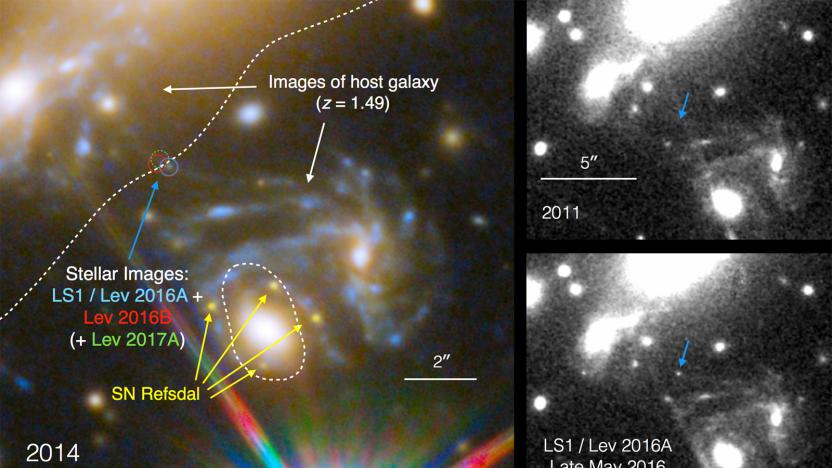
Hubble space telescope spots the farthest known star
Astronomers have spotted numerous extremely distant galaxies, but spotting individual stars is understandably much more difficult unless they go supernova. Sometimes, though, cosmic alignment works in their favor. Researchers using Hubble space telescope data have spotted Icarus (aka MACS J1149+2223 Lensed Star 1), a blue supergiant whose light was emitted when it was 9 billion light years away from Earth -- over 100 times farther than the previous record-setter. They captured the star thanks to a rare, ideal gravitational lensing effect where the star's light was magnified not only by the gravity of an in-between galaxy cluster 5 billion light years from Earth, but by a star inside that cluster. All told, the lensing magnified Icarus 2,000 times.

Hubble provides the cosmic background to a dark French opera
Grandiose space images from NASA's Hubble telescope might be the last thing you'd expect see in an early 20th century French opera. However, Marco Brambilla, the artist behind epic video art installations and Kanye West's "moving painting" music video for Power, has done just that. He created the video backdrop for a new production of Claude Debussy's Pelléas et Mélisande, currently running at the Opera Ballet Vlaanderen in Antwerp, Belgium.
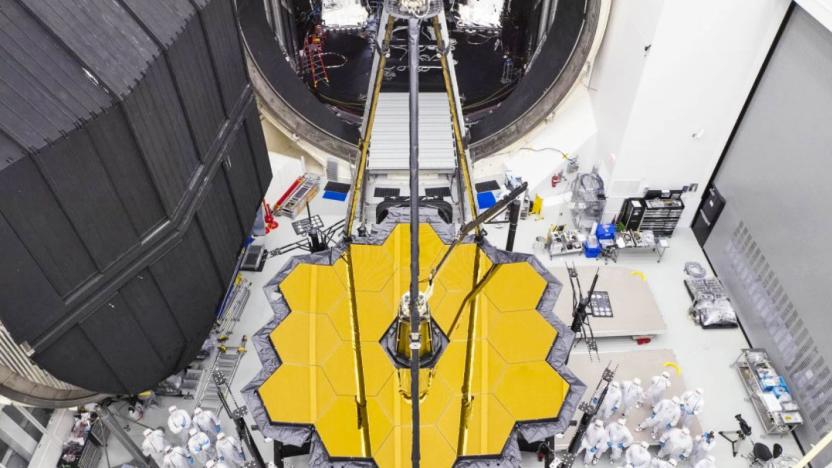
NASA's James Webb telescope is one step closer to launch
NASA's $8.8 billion James Webb Space Telescope (JWST) has just left the thermal vacuum chamber where it's spent more than three months being put through its paces in a series of hardcore cryogenic tests. Scientists wanted to make sure the telescope's instruments and optical element can function properly in the cold, airless conditions of space, and while NASA studies the results, engineers are busy putting JWST back together again, in preparation for its launch in spring 2019.
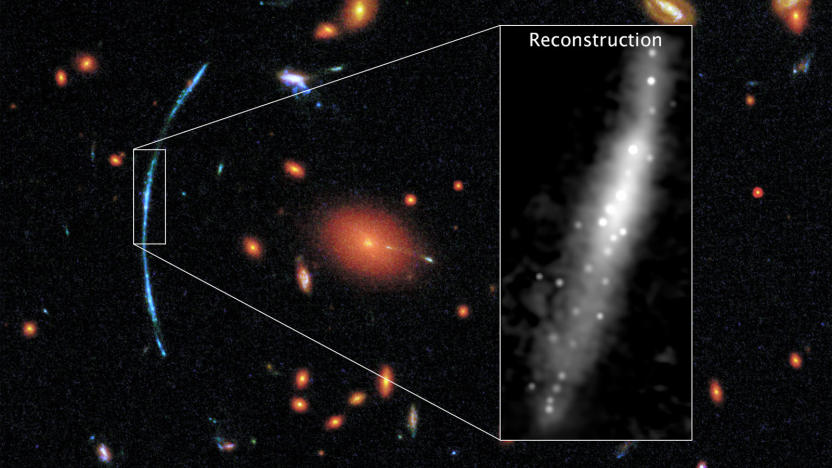
Early universe 'fireworks' challenge notions of how stars form
At the rate things are going, astronomers may have to toss out the rule book for galaxy formation. Researchers using the Hubble Space Telescope have discovered an ancient galaxy (formed 2.7 billion years after the Big Bang) with two dozen star nurseries measuring 'just' 200 to 300 light years across. That sounds big, but scientists had expected that early universe star-forming regions had to be enormous, at 3,000 light years across or larger. Here, they're so tightly packed together that NASA researcher Jane Rigby likens them to "fireworks" popping off at a cosmic scale.

Stars can turn into black holes without a supernova
As a rule, astronomers believe that stars have to explode in a supernova before they collapse into black holes. That violent death is always the cue, right? Not necessarily. Researchers have spotted a massive star 22 million light years away, N6946-BH1, that appears to have skipped the supernova step entirely -- it brightened slightly and just disappeared. Checks have ruled out a dimmed star or dust. And this probably isn't a one-off incident, either. Ohio State University's Christopher Kochanek tells NASA that 10 to 30 percent of massive stars might die in failed supernovae.

Hubble telescope spots 'runaway' black hole
Astronomers using NASA's Hubble Space Telescope have observed a supermassive black hole with a mass one million times that of our Sun hurtling away from its parent galaxy. It's the first confirmed case out of several suspected "runaway black holes," which required an immense amount of energy to get launched from the center of its galaxy. How much?
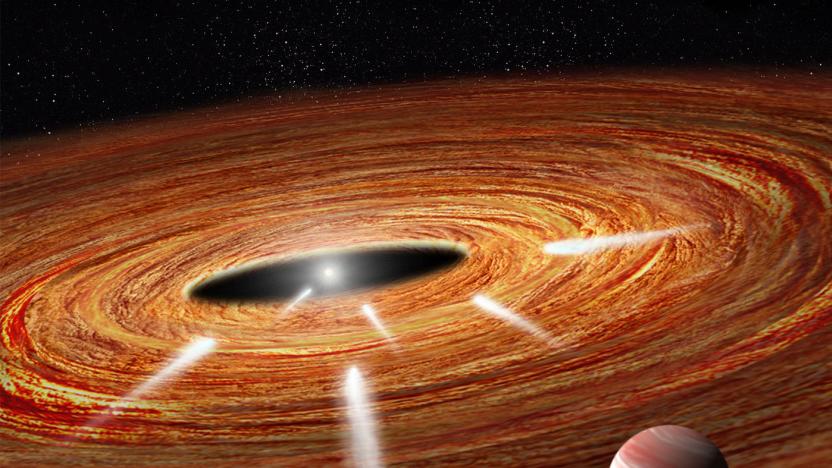
Hubble spots kamikaze comets plunging into a nearby star
The Hubble telescope helped a team of astronomers discover evidence of comets taking a dive into a young star called HD 172555 that's "only" 95-light years away from Earth. While they didn't exactly see these "kamikaze comets," Hubble detected some fast-moving silicon and carbon gases in the starlight close to the edge of the star's debris disk. The most likely explanation for those gases is that they're the result of comet-like objects shattering after crossing the star's disk.
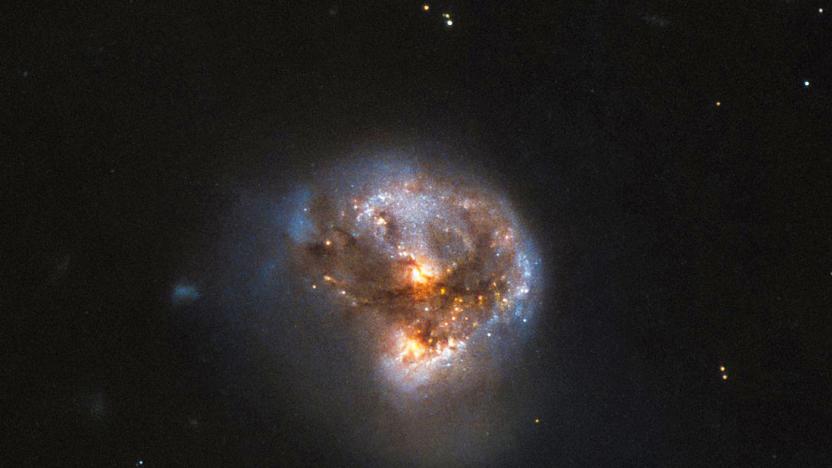
Hubble snaps a pic of a microwave-emitting galaxy
The Hubble telescope team is ending the year with a photo of an unusual galaxy, one that emits microwaves instead of visible light. See that image above? That's a snapshot of IRAS 16399-0937, a "megamaser" 370 million light-years away from Earth. Megamaser galaxies are intense and are around 100 million times brighter than the microwave-emitting areas -- or masers, found in star-forming regions -- of the Milky Way.
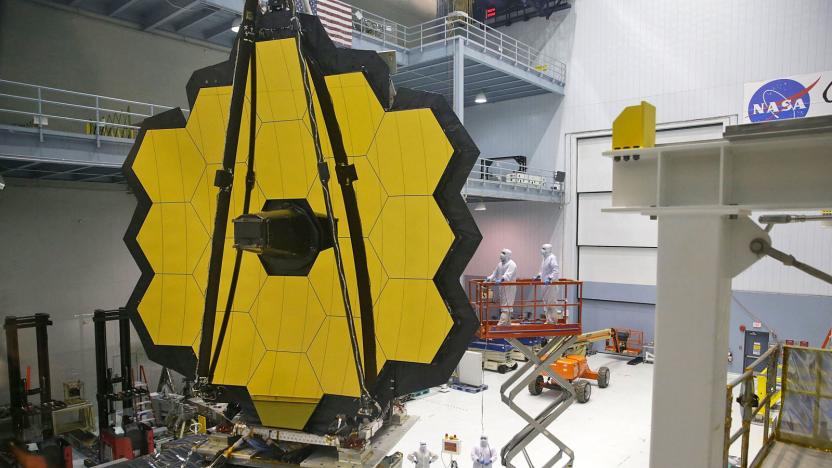
NASA has completed the $8.7 billion James Webb space telescope
The Hubble Space Telescope has given humanity unprecedented glimpses into the universe, but it will soon be replaced by a far more powerful model. NASA administrator Charles Bolden unveiled the completed $8.8 billion James Webb Space Telescope (JWST), which will be able to see the universe as it was 13 billion years ago. It's equipped with a 21-foot, gold-coated mirror array that can collect seven times more light than Hubble and scan the infrared spectrum to see through dust. "We've done two decades of innovation and hard work, and this is the result," project scientist John Mather says.

ICYMI: Read your dog's mood swings with tech
try{document.getElementById("aol-cms-player-1").style.display="none";}catch(e){}Today on In Case You Missed It: A new product out of Japan called Inupathy is giving dogs the Dug treatment, with a light up harness that tracks their heart rate, telling you information about their emotions via changes in color. We've no idea if it works as advertised, but you gotta admit the rainbow pattern signaling 'happy' is the most human expression for happiness in animals we could ever think of. Obviously your dog won't know what it means, since the silly loves are color blind.
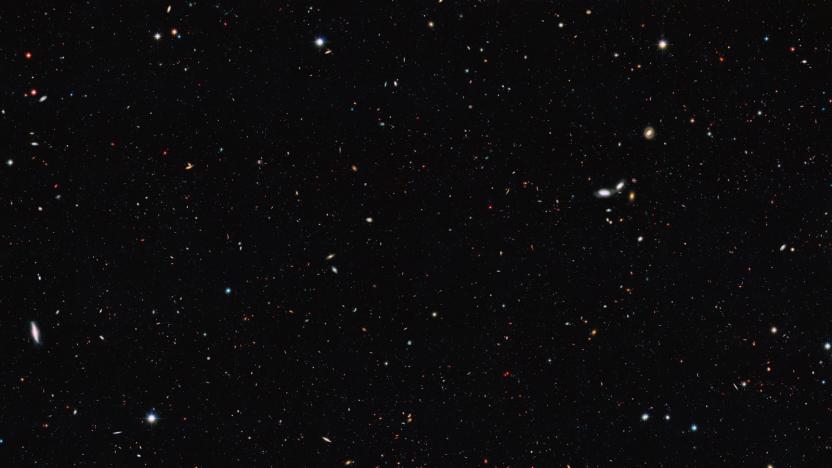
Universe may hold 10 times more galaxies than once thought
The observable universe was already incomprehensibly big, but it now looks to be even bigger. Astronomers have determined that are likely about 10 times more galaxies than previously thought, or between 1 trillion to 2 trillion. We just don't have the technology (or physical proximity) to detect them all, according to the researchers. They reached the conclusion after converting Hubble Deep Field images into 3D to study the number of galaxies at a given point in the universe's history, and using mathematical models to infer the possibility of galaxies that we haven't spotted. Simply speaking, the volume of galaxies seen over time doesn't make sense unless there are many we aren't aware of.

ICYMI: Roller coasters will be recommended by urologists
try{document.getElementById("aol-cms-player-1").style.display="none";}catch(e){}Today on In Case You Missed It: Researchers at Michigan State created a lifelike 3D model of a patient's kidney, with stones inside, and took it on a roller coaster after the man said the crystals cleared after riding Big Thunder Mountain. Turns out, the model backed it up and now, doctors will probably start recommending folks with smaller kidney stones ride roller coasters as treatment. The inner child of every adult just did a happy dance.

NASA observes possible water geysers on Europa
Hubble's extended mission continues to pay off: NASA announced today that a team of astronomers using the space telescope have spotted what appear to be plumes of high-altitude water vapor spewing from the icy surface of Jupiter's moon Europa. Researchers have long believed that Europa holds a global ocean beneath a thick, potentially miles-deep, layer of ice, but the new observation indicated it could be possible to sample the ocean without landing or drilling on the moon itself.
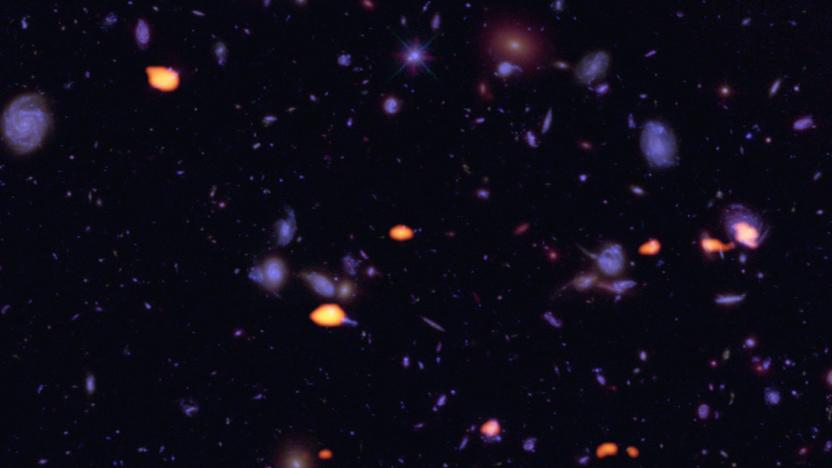
Hubble study helps explain the heyday of galaxy formation
The Hubble Space Telescope still isn't done giving up secrets of the early universe. Researchers using the Atacama Large Millimeter/submillimeter Array (ALMA) have discovered that a patch of 10 billion-year-old galaxies in Hubble's Ultra Deep Field view holds gas that helps explain the "Golden Age" of galaxy and star formation. This first completely "blind" (that is, not expecting anything) 3D millimeter wavelength search of the old universe turned up galaxies with an abundance of carbon monoxide, a hint that they were rich in the molecular gas key to creating stars.

NASA extends the Spitzer mission for two-and-a-half years
When the Spitzer telescope blasted off to space on August 25th, 2003, NASA didn't think it would still be doing science by 2016. But since it's alive and well 13 years later, the agency has granted it a two-and-a-half-year mission extension to make discoveries the astronomers "never imagined exploring with the spacecraft." The space telescope's next stage officially called the "Beyond phase" will begin on October 1st this year. It represents a period in the elderly spacecraft's life fraught with engineering challenges due to its age.
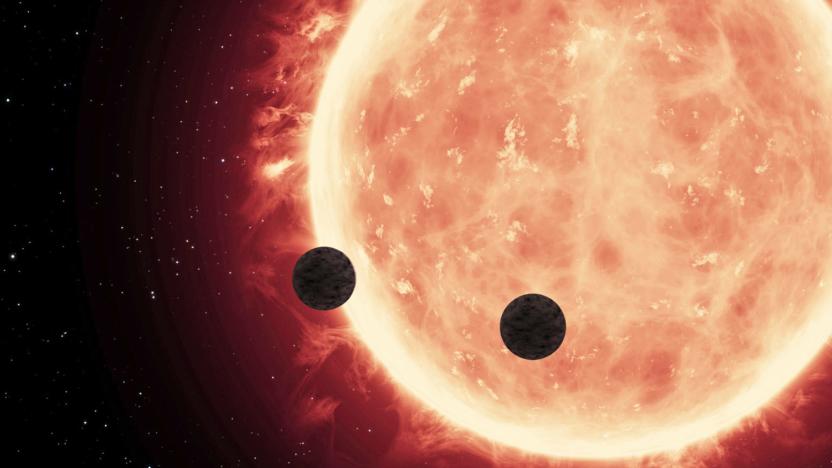
Hubble study finds two potentially habitable exoplanets
Scientists from MIT and the University of Liège studying a planetary system orbiting the star TRAPPIST–1 have discovered two rocky, Earth-like and potentially habitable planets only 40 light years away from home. According to a paper published in Nature today, the atmospheres on planets TRAPPIST–1b and TRAPPIST–1c are likely to be dense and compact like the atmospheres of Earth, Venus and Mars.
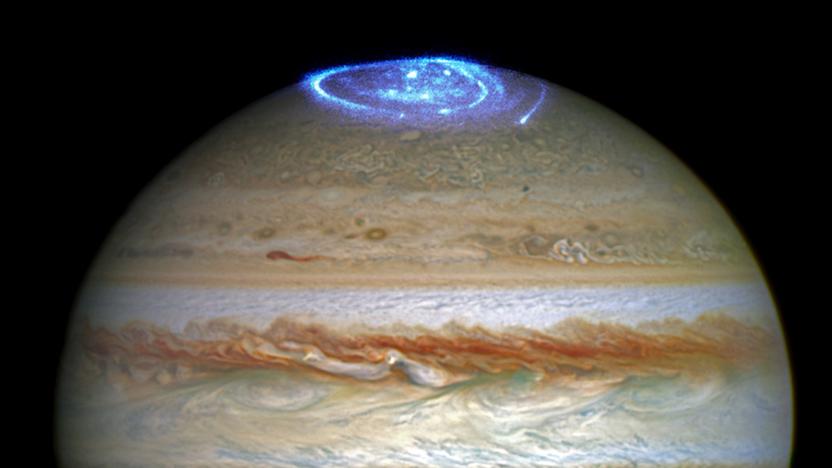
Hubble photographs Jupiter's dramatic auroras
The wispy, glowing veil sitting on top of Jupiter in the image above is actually a humongous aurora captured on cam by Hubble. A team of astronomers are using the telescope's ultraviolet instruments to study nature's light shows on the poles of the gas giant. They timed their study to coincide with Juno's arrival on the planet, since one of their goals is to determine how different solar wind conditions and other factors affect Jupiter's auroras. The spacecraft is in charge of measuring various solar wind properties, while they continue capturing images and videos almost every day during the duration of the mission.

NASA tasks the Hubble Telescope with five more years of service
Despite its successor launching in 2018, NASA is extending duty for the Hubble Space Telescope for another five years. The imaging spacecraft will continue to capture breathtaking photos from orbit until 2021 with the Space Telescope Science Institute in Baltimore. The final servicing mission to the telescope took place in 2009, and now it's set to provide images from our solar system and beyond into the next decade.

Hubble discovers a new 'dark vortex' on Neptune
Researchers gazing through NASA's hardworking, time-bending Hubble space telescope spotted a new storm brewing on Neptune last month. As the space agency confirmed today, research astronomers analyzing telescope data at the University of California at Berkeley discovered a new "dark spot" on the planet — only the third since Voyager 2 first spotted one in during its 1989 flyby.






